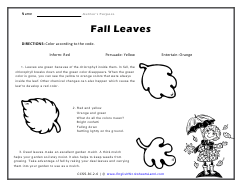Determining the Author's Purpose Worksheets:
Pandas - Some pandas like to be entertained and others like to be informed. Reading each of these three reading entries and see if you can understand why the author wrote these passages.
Fall Leaves - When are they red, yellow, and orange? We have the color indicate the purpose behind each passage.
Medusa - A little Greek mythology is always fun. Don't look at her! See if you can find the purpose behind each passage.
Fiction and Nonfiction - We have you write for purpose and use your imagination now. It's all about writing about trains.
Giraffes - You might need to do some research for this one. We give you another go with this topic.
Caveman Experience - Again, some research might be the key. I would guess that it is not all clubs and fire.
Identifying Types of Text - Identify the different types of text. Write persuasive, informative, entertaining to descriptive.
Types of Text - This four-door sedan is blue with a camel-colored interior. It has four cup-holders and a super sound system so that you can travel in style.
Types of Writing - Choose a topic. Then write a short paragraph about your topic in that style. For extra credit write a second passage in a different style.
Different Types of Writing - The text extracts below could have come from any of the following different types of writing: instructions, explanations, poems, myths, fables, novels or arguments.
What's your favorite animal? - Do some research about your favorite animal. Then write a few sentences about that animal in each box.
Finish It Up - We give you the first sentence, you give us the rest. You will write for purpose by reading the opening sentence. Imagine how the paragraph might continue if it is the first sentence in a piece of fiction. In the first box, write the rest of the paragraph as fiction. In the second box, write the rest of the paragraph as informative text.
Getting Housed - Write a few sentences to persuade someone to buy the house. Write a few sentences to persuade someone to buy the house.
Five To Choose From - Identify each type of writing below. There is an author's purpose box to help you along.
Ants - Who doesn't love ants? Write something you might read in a fiction and non-fiction book about ants.
Checklist - Ask yourself the following questions and your answers to these questions will point you towards understanding why it was written.
Choice of Books - Choose a book that you have read. Explain why the author wrote it, and how you know.
What Were They Thinking? - Put a check mark next to each characteristic that you found in the reading. When you are finished, say what you think about the work.
Scissor Time - Cut and paste into the correct columns.
The Spinner - 1. Print the page on card stock. Cut out the wheel and the pointer. 2. Attach the pointer to the wheel with a brass paper fastener. 3. Read short passages aloud to students. Have students spin the wheel and point to the purpose of each passage that you read.
Sentences and Paragraphs - Use this skill to breakdown the text that is coming your way.
Grab a Book - Pick up any book you want and give it a read, then use this worksheet.
How I Know... - Choose two books that you have read. Explain why the author wrote it, and how you know.
The Eviddence Trail - You will cite the reasons that you understand the intent of the author.
Inform, Persuade, or Entertain - Why in the world did they write this?
Text Types - Sort each type of text into the correct column.
Text Types/Features - Match each text type and the text features to the different reasons that a writer might use it to get their point across to their audience.
Which of the Three? - Each of the following sentences describes a text. Read each sentence. Then match the description of the text to the reason a writer might use it.
To Persuade - Find a book that fits that view point of a writer.
Organizer - A great sheet to use to help quickly understand why a writer wrote something.
Get FREE English Worksheets In Your Email

